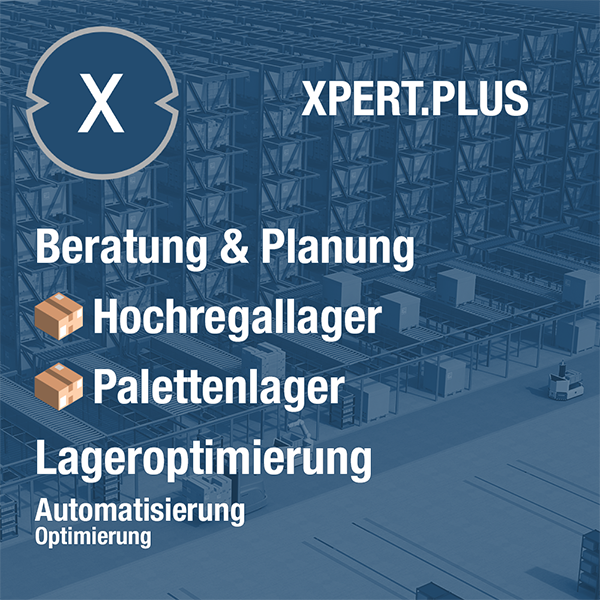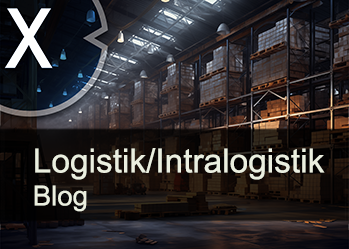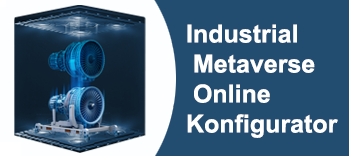Container High-Bay Storage Container solutions: From the intelligent container buffer warehouse to the logistics nerve system
Xpert pre-release
Language selection 📢
Published on: July 24, 2025 / update from: July 24, 2025 – Author: Konrad Wolfenstein

Container High-Bay storage container solutions: From the intelligent container buffer warehouse to the logistics nerve system – creative image: Xpert.digital
The redefinition of the container buffer: From the container terminal buffer zone to the logistics nervous system for container high-bay warehouse
Container High-Bay Storage: Analysis of a technological revolution in port and intralogistics
What do we mean by change from a pure buffer zone to a logistical nervous system?
The transformation of a container camp from a simple buffer zone to a logistical nervous system describes a fundamental paradigm shift in the functioning and strategic importance of container termals. In order to understand this change, you first have to shed light on the traditional role of a container camp. Historically, the container yard, i.e. the storage area in the harbor, was primarily a passive buffer zone. Its main task was to bridge the temporal and operational gap between the various transport companies – seagoing ship, railway and truck – Containers were parked here to wait for the further transport. The processes were largely reactive. A container was moved when a truck arrived for collection or a ship was ready for loading. This reactive nature inevitably led to inefficiencies, long waiting times and low predictability. The warehouse in its essence was a bottleneck, a necessary evil, the costs caused and slowed down the flow of goods.
The concept of the logistical nervous system, which is embodied by automated container high-base warehouse (HRL), turns this approach upside down. Instead of a passive buffer, the HRL acts as an active, intelligent and central control element of the entire terminal. It acts like the central nervous system of an organism. It continuously receives data flows from all connected systems: the arrival times of the ships (ETA), the booked time windows of the trucks, the timetables of the trains and the specific requirements of each individual loading unit. This information is not only collected, but processed in real time in order to proactively optimize the entire container flow. The HRL not only stores containers, it orchestrates its movements. It anticipates the future needs and positions containers forward -looking so that they are available at the exact right time with minimal effort for the next transport step.
This change has a profound economic consequence: the metamorphosis from a pure cost center to a value value. A traditional container yard is undeniably a cost driver. It consumes immense areas of often expensive, because city and water-sided, harbor base. It requires a high level of personnel and energy expenditure for the operation of diesel-powered industrial trucks and generates additional costs through inefficiencies such as multiple, unproductive surrounding (re-handling) and possible contractual penalties (demurring) for late handing off.
However, despite its high initial investment costs (Capex), a container high-bay warehouse is designed to generate actively generate value. The drastic increase in the envelope speed and the guarantee of high process reliability and predictability enables significantly faster ship handling times and high-efficient clockwork of truck and train reversal. This increased performance is a marketable service. A port with an HRL can offer shipping companies guaranteed, faster and more reliable service level and so attract more loads and larger ships. The warehouse is made by a passive area that causes costs, to a strategic assets that contribute directly to the sales and competitiveness of the port. This lies the core of the nervous system analogy: it actively improves the performance and “health” of the entire organism, port, and ensures its future viability in a globalized competitive environment.
Suitable for:
- The top ten of the container high-class bearing manufacturers and guidelines: technology, manufacturer and future of port logistics
Why did the traditional storage of containers reach its limits?
The traditional model of container storage, which is based on the extensive stacking of containers in large, open areas, has reached the limits of its performance from a combination of physical, operational, operational, economic and ecological reasons. These limits are the driving force behind the development of alternatives such as the high -bay warehouse.
In the first place is the area inefficiency. Conventional storage is extremely land -intensive. Containers are typically stacked with REACH Stackern or Portal Hubwagen (RTGS) in blocks up to a height of four to six units. This requires huge base areas. However, port areas are a finite and extremely valuable resource. Many of the world's most important ports are located in or in the immediate vicinity of large metropolises, where expansion is physically impossible or financially prohibitive. The pressure to master more envelope on the same or even a smaller area is immense and can no longer be mastered with the traditional method.
The second critical point is the operational inefficiency, which is most clearly manifested in the so-called “shuffling” or surrounding area. In a conventional stack, only the top container can only be accessed directly. If a container is to be removed from a lower position, all containers above it must first be removed and stored elsewhere. This process of unproductive surrounding is an enormous waste of time, energy and machine capacity. It is estimated that in a poorly organized, conventional yard up to 60% of all crane or vehicle movements can be unproductive surrounding. This leads to unpredictable and often long waiting times for trucks and delays the loading of ships.
Third, the high personnel dependency and the associated security risks are to be mentioned. Traditional terminals are dependent on a large number of drivers for REACH Stacker, terminal tractors and other devices. This not only leads to high wage costs, but also poses considerable potential for human errors. The mixing traffic of heavy machines and staff on the terminal site represents a permanent and significant security risk. Accidents that lead to injuries or even deaths are a sad reality in this environment.
A fourth weak point lies in the data and transparency gaps. The exact position and the status of thousands of containers in a spacious, constantly changing yard in real time is a big challenge. Although Terminal Operating Systems (TOS) support here, there are always deviations between the digital and the physical stock. This can lead to time -consuming searches, incorrect unloading and a general lack of transparency for the actors involved in the supply chain.
Finally, the ecological footprint is an increasingly intolerable factor. The operation of a large fleet of diesel-powered REACH stackers and terminal tractors leads to high fuel consumption and associated with considerable emissions of carbon dioxide (CO2), nitrogen oxides (NOx) and fine dust. At a time at which ports are part of the critical infrastructure, to improve their environmental balance and protect air quality in the neighboring urban areas, this operating model is no longer future -proof.
Basics and functionality of the container high-base bearing (HRL)
What exactly is a container high-bay warehouse and how does it differ from a conventional container terminal?
A container high-bay warehouse, often abbreviated as HRL, is a fully automatic, highly sealed warehouse and buffer system that is specially designed for the handling of ISO containers. The basic architecture differs radically from that of a conventional container terminal. Instead of stacking containers flat on the floor, they are stored in a multi -storey, solid steel shelf construction. It is best to imagine the system as a gigantic, automated file cabinet system for sea containers.
The decisive difference lies in the transition from a horizontal, surface -based warehouse logic to a vertical, shelf -based storage. This structural change is the key to solving the fundamental problem of traditional storage: the need for stacking. In an HRL, each container is placed in an individually assigned shelf. The shelf construction carries the entire weight so that the containers no longer load on each other.
This results in the most important functional difference: the direct access to each individual container at any time. While in a conventional stack according to the principle of “load-in, first-out” (LIFO) and access to the lower container is blocked, the HRL enables a real “random access”. Regardless of where a container is stored on the shelf – whether in the top or bottom, in the middle or on the edge of the alley – it can be reached and outsourced by the automated shelf operating devices without the movement of a single other container. This paradigm shift from a sequential to direct access is the technological basis for the immense increase of efficiency, speed and predictability, which characterizes an HRL. It is not just a different way to store, but a completely new way of controlling the container flow.
Which core components form an automated container-RLL?
An automated container high-lane warehouse is a complex socio-technical system that consists of several closely interlinked main components. These can be limited into four essential areas: the physical structure, the automated mechanics, the controlling software and the interfaces to the outside world.
The shelf: This is the physical skeleton of the warehouse. It is a massive, self -supporting steel structure, which can often reach a height of over 50 meters and consists of thousands of tons of steel. The scaffolding is divided into several long streets and forms a matrix of precisely defined storage spaces or subjects. These subjects are dimensioned in such a way that they can take up the common container sizes (e.g. 20 feet, 40 feet, 45 feet). The entire structure is designed for maximum stability and durability to withstand the enormous static and dynamic loads.
The shelf control units (RBG): They are the mechanical work horses of the system. At least one RBG is in every alley of the shelf. These are rail -guided, fully automatic cranes, which can move horizontally along the alley and at the same time vertically along their lifting mast. On the lifting mast, a load record is installed, typically a spreader that grabs the container, raises, lifts and inserted it into the shelf compartment or removed from there. The RBGs are designed at the highest speed and precision and work around the clock with minimal human intervention.
The software level: it is the brain of the entire system and decides on its performance. This level is typically structured hierarchically:
The Warehouse Management System (WMS) or the overarching Terminal Operating System (TOS): This is strategic intelligence. This system manages the entire inventory. It knows the identity, weight, the destination, the departure time and the priority of each individual container. Based on this data and the transmitted orders of shipping companies and freight forwarders, it makes the overarching decisions which container is to be stored when and where or provided for further transport.
The Warehouse Control System (toilet) or the Material Flow Controller (MFC): This is the tactical level. The toilet acts as a translator between the WMS/TOS and the physical machine. It receives the strategic instructions (e.g. “LAGERE container XYZ out”) and brings them into concrete, optimized driving orders for the individual shelf control units and conveyor technology. It controls the movements in real time and ensures a smooth and collision -free material flow within the warehouse.
The transfer areas: These are the critical interfaces at which the HRL interacts with the outside world and hand over containers to the subsequent or by the previous transport chains. Depending on the terminal concept, these areas can be designed differently. Often there are special transfer stations where the containers from the RBGs to other automated systems such as driverless transport systems (automated guided vehicles – AGVs) or rail-bound portal cranes (Rail-Mounted Gantry Cranes – RMGS) are handed over, which take over the transport to the Kaikante or to the rail terminals. There are dedicated, often automated truck charging bays for truck traffic, on which the containers are placed directly on the chassis of the trucks.
How does the process of depositing and outsourcing a container work in such a system?
The life cycle of a container within a high -bay warehouse can be divided into three core processes: the storage, rearrangement and outsourcing. Each of these processes is precisely controlled by the interaction of the software and the mechanical components.
The process of storage begins when a container arrives at the terminal, for example by truck. The truck drives to a designated handover station on the edge of the HRL. The identification number of the container (e.g. via OCR gates or RFID tags) is automatically recorded there and compared with the order data stored in the Terminal Operating System (TOS). As soon as the container is identified and released, the truck driver (or an automatic system) hands over the container to the interface of the HRL. At that moment, the Warehouse Management System (WMS) takes control. Based on a variety of parameters – such as the weight of the container (for optimal load distribution on the shelf), its target port, the planned departure time of the ship and the current occupancy of the warehouse – the WMS charges the optimal storage area. This decision will be passed on to the Warehouse Control System (toilet), which then provides the nearest, available, available shelf control unit (RBG) with the transport order. The RBG drives autonomously to the transfer station, absorbs the container, transports it to the assigned shelf and stored it precisely there. The entire process is booked in real time in the WMS.
The recovery is a process that best demonstrates the intelligence and proactive character of the HRL. It is an “intelligent shuffling” that, in contrast to the reactive surrounding stacks, is in conventional camps. The system works with a forward -looking manner during times, for example at night or between the arrivals of large ships. The WMS/TOS analyzes the upcoming ship and truck handling for the next few hours or even days. It identifies containers that will soon be needed, but are currently still stored in unfavorable places, because far from the transfer stations. The system then generates internal inventory orders. The RBGs systematically move these containers to storage areas that are closer to the corresponding outsourcing points. A container that is intended for a ship that takes place at 9 a.m. is brought into an optimal “starting position” for quick outsourcing at 4 a.m. This process maximizes the efficiency during top load times and is a decisive factor for ensuring short termination times.
The outsourcing is triggered when an external need is registered, be it by arriving a truck to pick up or the start of loading a ship. The order is recorded in the TOS, which in turn shows the WMS to provide the specific container. The WMS knows the exact position of the container and forwards the outsourcing order to the toilet. The toilet instructs the responsible RBG to get the container out of his compartment and to transport it to the predefined transfer station. There he is either loaded directly to a truck chassis or handed over to an AGV that brings him to the Kaikan. Since the container is often optimally positioned thanks to the intelligent shuffling and no other container stands in the way, this process can be completed in a few minutes and with an extremely high temporal precision.
What role does the software level play, especially the interaction of WMS, WCS and TOS?
The software level is undeniably the most critical component for the performance of a container high-bay warehouse; It is the real nervous system. Without a highly developed, perfectly integrated software architecture, the impressive steel and machine construction would only be an inefficient and unusable investment. The interaction of the various software layers – Terminal Operating System (TOS), Warehouse Management System (WMS) and Warehouse Control System (toilet) – the efficiency, intelligence and ultimately the economic success of the entire system.
The Terminal Operating System (TOS) acts as the overarching brain of the entire port terminal. It is the central planning and administration platform that retains the overall overview. The TOS communicates with external actors such as shipping companies, freight forwarders, customs authorities and rail operators. It manages ship's runs, truck time windows, allocations and the associated container movements across the entire terminal site – from the quays to the warehouse to the gate. With regard to the HRL, the TOS specifies the strategic framework: “Which containers arrive when?”, “Which containers have to be available for which ship until when?”.
The Warehouse Management System (WMS), which is often designed as a specialized module within the TOS or as a closely connected subsystem, is the master planner especially for the high-bay warehouse. The WMS not only decides that a container has to be stored, but also where exactly. It uses complex algorithms to find the optimal storage space for each individual container. It takes dozens of variables into account: the dimensions and the weight of the container, dangerous goods classifications, the planned time of delivery, the occupancy of the alleys and even the energy efficiency of the RBG trips. The WMS is also responsible for planning the proactive relocations during the side times to maximize performance at peak times.
The Warehouse Control System (toilet), also called Material Flow Controller (MFC), forms the lowest, executive level of the software hierarchy. It is the conductor of the machine orchestra. The toilet receives the concrete warehouse and transport orders from the WMS (e.g. moving container A from place X to Platz y ”) and brings them into precise, sequenced movement commands for the individual hardware components- – the shelf control units, conveyor belts and other mechanical elements. It controls the engines, sensors and actors in real time, monitors the position and speed of each device and ensure that all movements are carried out safely, collision -free and efficiently. The toilet is the direct interface to the physics of the warehouse.
However, the true ingenuity of the system is not in the individual functions of these layers, but in its seamless and symbiotic integration. There is a profound, co-evolutionary relationship between the hardware (the physical warehouse) and the software. One could assume superficially, the software only “controls” the hardware. In truth, they allow each other. The physical design of the HRL with its individual container access is the basic requirement that the optimization algorithms of the software can become effective at all. Such algorithms would be useless in a traditional stacking bearing. Conversely, the sophistication of the software – for example the ability to prepare the warehouse occupancy with predictive analyzes based on ship's timetables and traffic data – determines the actual return on investment of the millions of hardware. A primitive control system would even make the most advanced HRL inefficient. This relationship continues to develop. Advances in the sensors of the cranes (hardware) provide more rich data (e.g. precise weight measurement, condition scans of the container) to the WMS/TOS (software). These new data in turn enable the development of more advanced algorithms, for example for a dynamic load distribution on the shelf or for forward -looking maintenance (predictive maintenance). The future development of HRL, driven by artificial intelligence, is the ultimate expression of this symbiosis, in which the system learns and optimizes itself, based on the continuous feedback loop between its physical actions and its digital brain.
Future of the container handling: More efficiency in a minimal area
Strategic and operational advantages
What quantitative advantages does an HRL offer in terms of space efficiency?
The most outstanding and easiest quantifiable advantage of a container high-base bearing is the dramatic increase in area efficiency. In an industry in which land is one of the scarce and most expensive resources, this factor is of crucial strategic importance. The ability to drastically increase the storage capacity per square meter is often the primary trigger for investing in this technology.
The numbers speak a clear language. A modern HRL can achieve a storage capacity of well over 2,000 TEU (Twenty-Foot Equivalent Unit, the standard unit for a 20-foot container) on an area of a hectare (corresponds to 10,000 square meters). Some of the most advanced designs even aim at values of up to 2,500 TEU per hectare.
If you place this value in the context of traditional warehouse methods, the extent of the compression becomes clear. A warehouse block operated with rail -bound portal cranes (RMGS), which is already considered relatively surface -efficient, typically reaches a storage density of around 700 to 1,000 TEU per hectare. The HRL already offers a doubling to tripling the capacity. The comparison with the most widespread, but also the least efficient method – stacking with mobile reachers – is even more drastic. A Yard, who is managed with REACH, often only reaches a density of 200 to 350 TEU per hectare. Compared to this method, an HRL can increase the storage capacity on the same area by a factor of six to ten.
A prominent practical example is the Boxbay system developed by DP World and the SMS Group, the first facility of which was installed in Jebel Ali in Dubai. The operators state that this system enables up to 70% to reduce the space requirement compared to a conventional stacking bearing. This means that the same number of containers can be stored in less than a third of the original area.
This massive compression is more than just an operational optimization; It can be a catalyst for a comprehensive urban planning and port economy new development. The primary benefit is the saving of space. The secondary benefit is the avoidance of costs for the acquisition of new, expensive land. However, the deeper, strategic importance lies in the opportunities that arise from non-compression. The area that is released by the implementation of an HRL is often first-class port or urban area near the water. This recovered country becomes a strategic asset for the port authority or the terminal operator. It can be rededicated for higher -quality activities that contribute directly to the increase in sales and strengthen the competitive position. For example, the expansion of the kaian layers in order to be able to handle more or larger ships at the same time are conceivable, the development of new logistics services such as packaging, consolidation or customs handling centers or even leasing or selling the areas for commercial or public purposes. This can improve the integration of the port into the urban environment and open up completely new sources of income. The investment in an HRL is therefore not only an operational decision to increase efficiency, but also a far-reaching strategic decision in the field of real estate and urban development.
Suitable for:
- The simple and evolutionary-grown idea of the container base camp: a paradigm shift in global logistics
How does automation affect the cover speed and reliability?
Automation from a high -bay warehouse has profound and positive effects on two of the most important performance indicators of a terminal: the envelope speed and the reliability of the processes. These improvements affect all interfaces of the terminal, in particular the handling of trucks and ships.
A central advantage is the drastic reduction in truck handling times, often referred to as “Truck Turnaround Time”. In conventional terminals, waiting times of 30 to 90 minutes or even longer are not uncommon. This variability and unplannable represents a significant cost and frustration factor for freight forwarders. An HRL can reduce these times to less than 20 minutes. This is made possible by several factors: the truck drivers interact with a highly efficient, automated interface. The requested container is available within minutes thanks to the direct access and the proactive rearrangement. The time -consuming search and the unproductive surrounding are completely eliminated.
This speed goes hand in hand with unprecedented reliability and predictability. The system can offer guaranteed, short deployment and pick-up times. Since each container can be reached individually at any time and the performance of the system is determined by the software, the uncertainty that characterizes traditional operations disappears. For a shipping company or a freight forwarder, this means that you can rely on the time window promised by the terminal. This reliability is a crucial sales argument and a strong competitive advantage. It enables the downstream actors to plan their own processes and resources (just-in-time logistics).
The basis for this speed and reliability is the already mentioned elimination of the unproductive surrounding. In an HRL, almost every movement of a shelf control unit is a value -adding movement – either a storage, outsourcing or a planned, intelligent rearrangement. The waste of resources for reactive correction movements is reduced to close zero. This leads to a significantly higher throughput with the same or even lower number of machines used compared to a conventional fleet.
Another, often underestimated aspect is 100 percent data accuracy and transparency. The moment a container is checked into the system, its position in the three -dimensional space of the warehouse on the centimeter is well known and is mapped in real time in the WMS/TOS. “Lost” containers that require time -consuming searches are a thing of the past. Every authorized player in the supply chain can call up the exact status and the planned availability of a container at any time. This complete data integrity eliminates sources of error, reduces the administrative effort and creates a level of trust and transparency that is unreachable in manual systems.
To what extent does an HRL improves occupational safety and working conditions?
The introduction of a container high-base bearing leads to a fundamental improvement in occupational safety and a sustainable change in working conditions on the terminal. The security gain is one of the most significant, although not always monetary, advantages of this technology.
The primary safety improvement results from the consistent physical separation of humans and machines in the central storage area. The entire area within the shelf freedom in which the heavy and rapidly moving shelf operations operate is a zone inaccessible to humans. In contrast, a traditional container yard is staggered by dangerous mixing traffic of up to 70 tons of reachers, terminal tractors, external trucks and on foot (introductory, inspectors). This constellation carries a high risk of serious and fatal accidents from collisions, starting people or falling loads. The automation and creation of “no-go areas” for personnel is practically eliminated. Human interaction only takes place on the clearly defined and secured interfaces on the edge of the HRL.
In addition, the technology changes the nature of the work itself. The exhausting, physically stressful and often under adverse weather conditions are eliminated by the drivers of industrial trucks. New, more sophisticated and safer job profiles take your place. The employees no longer work in the loud and dangerous surroundings of the yard, but in air -conditioned, ergonomically designed control rooms. Your task changes from the manual control of a single machine to monitor the entire automated system. They act as system operators who pursue the material flow on screens, intervene in the event of disruptions and analyze the performance of the system.
Other new roles are created in the area of maintenance and maintenance. The highly complex mechanics and electronics of shelf operations and conveyor technology requires highly qualified mechatronics and IT specialists. These jobs are knowledge -based, technologically demanding and offer long -term development perspectives. Automation leads to a decline in traditional driver jobs, but at the same time it creates new, high -quality and, above all, safe jobs. This change helps to increase the attractiveness of the port work as a whole and to counteract the shortage of skilled workers in the logistics industry.

To what extent does an HRL improves occupational safety and working conditions? – Image: Xpert.digital
The comparison between a traditional camp with REACH and an automated high -bay warehouse (HRL) shows significant advantages for occupational safety and working conditions. While traditional storage systems are characterized by high personnel requirements and risks in mixed traffic, HRL offers a very high level of safety with separate traffic zones. Personnel needs drop from several drivers and referrers to a minimum, which primarily includes monitoring and maintenance tasks.
The security improvements result from several factors: direct access to any container, minimized manual interventions, separate work areas and fully automatic control. In addition, the proportion of unproductive strokes is reduced from 40-60% to less than 1%. The terminating times for trucks can be reduced from 30-90 minutes to under 20 minutes.
In addition to occupational safety, an HRL also improves the total working conditions through real-time data availability, lower CO2 emissions through electrical drives and a significantly higher storage density of over 2,000 TEU per hectare compared to 200-350 TEU in the traditional system.
Implementation and technological challenges
What are the biggest challenges in planning and implementing a container-HRL?
Implementation of a container high-base bearing is a highly complex major project that is associated with considerable challenges and risks. These extend from financing to technical integration to the construction phase and require extremely careful and long -term planning.
The first and often biggest hurdle are the enormous investment costs (Capital Expenditure – Capex). These are projects whose costs can move in the high double-digit to three-digit million-euro area. Securing such extensive financing requires a very robust business case and the trust of investors in the long -term profitability of the project.
Another central challenge is the complexity of IT integration. The heart of the HRL, the software level of WMS and WCS, must communicate seamlessly and flawlessly with the overarching terminal operating system (TOS) of the port as well as with other surrounding systems such as the gate system for trucks, the customs system or the railway disposition. This integration is a demanding IT major project. Interfaces have to be defined, data formats have to be compared and processes tested end-to-end. Every error in communication between the systems can lead to massive operating disorders. The selection of the right software partner and professional project management are of crucial importance here.
The construction and commissioning phase itself is also a big challenge. The civil engineering for the foundations that have to wear the immense weight of the shelf construction and containers requires the highest precision. The assembly of the kilometer -long steel shelf and the installation of the shelf control units are logistical masterpieces, which often take place under cramped space. After the mechanical and electrical installation, an intensive phase of commissioning and the focus follows. In this phase, the interaction of all components is tested under realistic conditions, the software is fine -tuned and the system is gradually raised. This process is time -consuming and critical to ensure the contractually agreed service and reliability.
After all, it makes a significant difference whether the HRL is built on a “green meadow” (Greenfield) or in an existing, running terminal (Brownfield). A Greenfield project is comparatively easier because it can be built on an empty area regardless of existing processes. The implementation in a Brownfield environment is much more complex. The construction often has to take place in several phases in order to disturb the ongoing terminal operation as little as possible. This requires sophisticated construction site logistics, temporary traffic tours and precise coordination between the construction team and the operational staff of the terminal. The challenge of performing a technological heart transplant on the open, beating heart of the port is immense.
What risks are connected to the operation of such high -automated systems and how can they be managed?
The high degree of automation that makes up the strength of an HRL also harbors specific company risks that have to be carefully managed to ensure system availability and security.
The most prominent risk is that of a “Single Point of Failure”. Since the HRL is a highly integrated system, the failure of a central component could potentially paralyze the entire operation. A large -scale power failure, a total failure of the central server cluster on which the WMS/TOS runs, or a catastrophic mechanical defect in an RBG that blocks an entire alley are serious scenarios. Risk management meets this danger through consistent redundancy. Critical systems are interpreted twice or several times. This includes interruption -free power supply (UPS) and emergency power unit, mirrored servers in separate fire sections and the possibility to compensate for the tasks of a unusual RBG at least partially by another device in the alley (if available) or by neighboring streets. In addition, robust emergency and re-starting procedures are essential in order to be able to react quickly and orderly in the event of a fault.
Another risk is in the area of maintenance and maintenance. The complex mechatronics of the system requires highly specialized maintenance staff who have profound knowledge of mechanics, electrics and IT. A lack of such specialist staff can lead to extended downtimes. In order to counter this risk, modern HRL operators rely on a proactive, data-based maintenance strategy. Instead of waiting for a failure (reactive maintenance), sensor data is continuously analyzed by the machines in order to identify wear patterns and predict maintenance (predictive maintenance). Components can be replaced before they fail, ideally during planned maintenance windows without affecting the company.
An increasingly important risk is cyber security. As a networked, software -controlled system, a HRL is a potential goal for cyber attacks such as ransomware or sabotage files. A successful attack could not only stop operating, but also compromise sensitive data or even cause physical damage. The protection of the IT infrastructure is therefore not negotiable. This requires a multi-layered security concept that ranges from firewalls and intrusion detection systems to strict access control to regular training of employees. Cyber security must be understood as an integral part of the entire system design and ongoing operation.
Intelligent warehouse technology: How AI transforms the container envelope
Economic considerations and return on investment (ROI)
Which investment costs (Capex) must be expected for a container-hen?
The investment costs (Capital Expenditure – Capex) for the construction of a container high-distance warehouse are significant and represent one of the greatest hurdles for the realization of such projects. A flat rate indication of the costs is difficult because they depend on a variety of factors, including the planned storage capacity, the amount of the shelf, the degree of automation on the interfaces and the specific geological and structural conditions of the location.
In general, the project costs in the high double-digit to three-digit million-euro area are moving. This sum is made up of several large cost blocks. A significant proportion does not apply to the deep and construction work (Civil Works). This includes the preparation of the building ground, the creation of the massive concrete foundations and the construction of the installation or roofing of the warehouse.
The largest individual item is usually the steel and machine construction itself. This includes the delivery and assembly of the complete, heavy shelves as well as the purchase of the entire automated machine, i.e. the shelf operating devices (RBGS), the conveyor technology at the interfaces and possibly other automated vehicles such as AGVs for further electricity.
Another essential cost factor is the entire software and IT package. This includes the licenses for the Warehouse Management System (WMS) and the Warehouse Control System (WCS), the costs for the integration of these systems into the existing Terminal Operating System (TOS) and the purchase of the necessary server hardware, network technology and sensors. The complexity of these software solutions and the associated development and adaptation effort make this item a part of the overall investment that should not be underestimated. The specific costs are ultimately determined by the tender and award to specialized general contractors or system integrators that offer such turnkey systems.
Suitable for:
How do the operating costs (Opex) sit down and how do they behave compared to traditional camps?
While the investment costs (Capex) of an HRL are very high, in return it is characterized by significantly lower ongoing operating costs (operating expendite – opex) compared to a conventional container yard. These opex savings are the crucial lever for the long-term economy of the system.
The biggest savings effect results in personnel costs. A traditional yard needs a large number of drivers for REACH Stacker and terminal tractors who often work in three-shift operation. A HRL drastically reduces this personnel requirement. The physical work is taken over by automated systems. The personnel requirements are limited to a small, highly qualified team for monitoring in the control room and for specialized maintenance.
Another essential point is the energy costs. A fleet of diesel -powered REACH stackers has enormous fuel consumption. The electrically powered shelf control units of an HRL are much more efficient here. A decisive advantage is your ability to recuperation: When braking and lowering loads, kinetic and potential energy is converted into electrical current and fed back into the system. This can reduce the net energy consumption per container movement by up to 40% and leads to considerable cost savings in the case of electricity supply.
The maintenance and maintenance costs, considered per moved container, are also tend to be lower. Although HRL technology requires specialized maintenance, the maintenance of a large fleet of individual vehicles with internal combustion engines, driven and hydraulic systems, which are very maintenance-intensive. The centralized and standardized technology of the HRL enables more efficient maintenance processes.
In addition, various additional costs decrease. The insurance premiums can be lower due to the massively reduced accident risk. The costs incurred by damage to containers or loading in the event of improper handling are practically eliminated. There are also potential contractual penalties or fees of shipping companies that occur for delays in ship processing, since the HRL ensures punctual and quick provision of the containers. All in all, these savings mean that the opex of an HRL Pro handled container is significantly below those of a traditional terminal.
Which factors are crucial for the calculation of the Return on Investment (ROI) and about what period is it typically achieved?
The calculation of the Return on Investment (ROI) for a container high-class warehouse is a complex analysis that goes far beyond a simple comparison of Capex and opex savings. In order to grasp the true profitability, a number of direct, indirect and strategic value drivers must be taken into account.
The crucial quantitative factors on the HAVES side are:
- The direct Opex savings, primarily through reduced personnel and energy costs.
- The value of the saved area. This factor is particularly important in land shortages, expensive port locations such as Singapore, Hamburg or Los Angeles. The value can be set either as avoided costs for the landing acquisition or as an opportunity yield from the alternative use of the vacant area.
- The income from the increased envelope capacity. An HRL enables the terminal to switch more containers a year, which leads directly to higher sales proceeds. In addition, the ability to prepare larger ships faster can attract new, lucrative line services.
- The avoided costs through the elimination of inefficiencies, such as container damage, incorrect unloading and penalty payments for delays.
The typical amortization period for an HRL is usually between 7 and 15 years. However, this range depends heavily on the local framework conditions. In ports with very high property and wage costs, the ROI can be reached faster than at locations where these factors play a lower role.
However, a purely financial ROI view falls short. The strategic dimension of the investment is often just as important. This shows an apparent paradox: the high investment costs, which are often considered the greatest risk, actually serve to reduce far larger, long -term strategic risks. The investment in an HRL is a strategic protection against a number of escalating threats that are inherent in the traditional operating model. It reduces the risk of future labor shortages and wage cost inflation in the commercial sector. It reduces the financial and reputable risk of serious work accidents.
The most important thing, however, is that it reduces the market risk of losing customers – i.e. the global shipping companies – to more efficient, faster and more reliable competition ports. In a highly competitive global market, in which shipping companies select your contact ports according to efficiency criteria, the risk of non-investment and the resulting technological outdoorness can be far greater than the financial risk of investing itself. A port that is unable to efficiently handle the largest container ships. The ROI calculation must therefore also take this “risk reduction value” into account. The investment is therefore less an option than a strategic need to secure the future viability of the location.
Future perspectives and integration into the logistics ecosystem
Which future technological developments will shape container high-bay warehouse?
The technology of the container high-bay warehouse does not stand still, but will develop in the coming years through a number of technological advances. The trend is clearly towards an even higher autonomy, intelligence and networking.
A central focus is on the increased use of artificial intelligence (AI) and machine learning. Today's systems are already working with complex algorithms, but are still strongly based on inevitable logic. Future systems will pass from this rule -based control to real, learning autonomy. A AI will be able to optimize the warehouse strategy not only on the basis of static timetables, but in real time, including a variety of dynamic data feeds. This includes live weather data that influence the arrival time of ships, current traffic information on access roads and even predictive analyzes about the global streams of goods. The same AI systems will also raise the forward-looking maintenance (predictive maintenance) to a new level by learning anomalies from the sensor data of the machines and can predict failures with high precision before they occur. In addition, AI is used for the dynamic control of energy consumption to avoid load tips and to adapt the energy troubleshoot to the availability of renewable energies.
Another key technology is the “digital twin”. A complete, virtual 1: 1 image of the physical HRL is created in a simulation environment. This digital twin is fed with real -time data from the physical warehouse and exactly reflects its condition. The possible uses are diverse: new software updates or optimization algorithms can be tested and validated on the digital twin without risk before being implemented in the live system. The digital twin can be used to simulate different operating scenarios to identify bottlenecks and improve the system performance. It also offers a safe environment for training operating and maintenance staff.
In the area of hardware, advanced robotics and image processing systems will play a larger role. Small, autonomous robots that drive through the shelf and carry out automated inspections of the container state are conceivable to document dents, holes or other damage. High-resolution cameras and AI-supported image recognition could automatically read and verify dangerous goods labels or even carry out smaller maintenance work on the containers themselves. These technologies will further improve the data basis and to deliver the degree of automation to the last manual interfaces.
What role do sustainability aspects such as energy efficiency and CO2 reduction play in the design of future systems?
Sustainability is no longer a niche topic, but a central driver in the conception and the operation of modern port infrastructure. The imperative of the “Green Port” significantly shapes the development of future HRL systems, whereby the advantages come into play on several levels.
HRL are already much more sustainable in their basic concept than traditional container yards. The decisive factor is the complete electrification of the warehouse operations. The replacement of a large fleet of diesel-powered REACH and terminal tractors by electrically powered shelves eliminates the direct emissions of CO2, nitrogen oxides and fine dust in the heart of the terminal. This leads to a drastic improvement in local air quality, which is particularly important for ports in urban areas. The recuperation technology already mentioned, in which brake energy is recovered, significantly increases energy efficiency and lowers the total energy requirement per handled container.
Future concepts will further strengthen this sustainability focus. In the area of the construction, lightweight construction and the use of recycled or more sustainable materials for the shelf is observed. The software for controlling the RBGS is further optimized to minimize the roads and reduce energy-intensive acceleration and braking processes. However, the most important step will be the integration of renewable energy sources. The large roof areas of an in-house HRL offer ideal conditions for the installation of photovoltaic systems. The aim is to produce a significant part of the required electricity directly on site to generate CO2-neutral and ideally make the HRL an energy self-sufficient or even energy-positive component of the port.
However, considering the sustainability goes beyond the system itself and has its effect on several levels.
The first level is the direct operational benefit: the HRL itself is more energy -efficient and less emission, which lowers operating costs and facilitates compliance with environmental requirements.
The second level is the benefit at the terminal level: the elimination of diesel emissions from the warehouse improves the entire environmental balance of the port and strengthens its reputation among authorities and in the local community.
The third and strategically most important level is the benefit for the entire logistics ecosystem. By drastically shortening the handling times for ships and trucks, the HRL reduces the idle times of thousands of external vehicles and ships that would otherwise wait for their handling with running engines. A truck that spends 20 minutes in the port instead of 90 minutes emits fewer emissions. A ship that can leave the port a day earlier reduces its fuel consumption. The HRL thus contributes to the decarbonization of the entire supply chain, not just that of the port. This systemic benefit is a strong argument for ESG-focused investors and for customers – in particular large shipping companies and shippers – who are even under pressure to make their supply chains more climate-friendly. The HRL becomes a decisive component and pioneer for a “green logistics corridor” and thus an important competitive differentiator.
How will the function of the Container-HRL develop within the global supply chain?
The function of the container high-bay bearing will develop from a pure, albeit highly efficient, harbor solution into an integral and networked node in the global logistics ecosystem. His role will grow beyond the limits of the terminal and the structure of the supply chains will change sustainably. The vision is that of a physical internet in which the HRL acts as an intelligent, data -controlled router for goods flows.
A major development will be the expansion of the HRL concept into the hinterland. We will see how such systems are not only built in seaports, but also at strategic inland – at large freight transport centers, at important railway corRidors and near large industrial and consumption centers. These “domestic ports” or “Dry Ports” are used as buffer and sorting centers, the containers closer to their final destinations. This enables decoupling long -distance transport (ship, train) from the short -range transport (truck), which leads to a better utilization of the modes of transport and a reduction in road traffic in the dams.
At the same time, the HRL will become a central data hub. Due to the 100 percent transparency about each container in the system, it will offer all involved in the supply chain an unprecedented planning and visibility. A loader or freight forwarder will not only know that his container has arrived in the port, but will also know with great reliability when this container will be available for collection. This predictive information enables the following logistics processes much closer and is the basis for real Just-in-time or just-in-sequence delivery concepts.
Ultimately, the container high-class bearing is the physical manifestation of the concept of “Logistics 4.0”. It is a cyber-physical system that seamlessly connects the digital and physical world. It is fully integrated, highly automated, data -controlled and trimmed for maximum efficiency. The projects already realized or under construction in global control ports such as Jebel Ali (Dubai), Tanger Med (Morocco) or the plans for the Hamburg port are not isolated individual cases, but the harbing of this far -reaching transformation. They show that the HRL finally takes off its role as a passive buffer and establishes itself as the true, indispensable nervous system of future global trade.

Xpert.plus warehouse optimization – high -bay warehouse such as pallet warehouse advice and planning
We are there for you – advice – planning – implementation – project management
☑️ Our business language is English or German
☑️ NEW: Correspondence in your national language!
I would be happy to serve you and my team as a personal advisor.
You can contact me by filling out the contact form or simply call me on +49 89 89 674 804 (Munich) . My email address is: wolfenstein ∂ xpert.digital
I'm looking forward to our joint project.




























